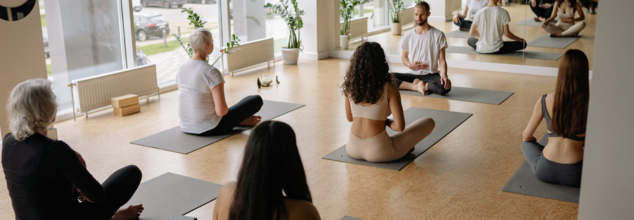- Health Conditions A-Z
- Health & Wellness
- Nutrition
- Fitness
- Health News
- Ayurveda
- Videos
- Medicine A-Z
- Parenting
- Web Stories
How To Perfect The Glute Bridge For Stronger Buttocks, Core Stability

Glute Bridges (Credit: Canva)
Whether you're lifting heavy weights at the gym or sitting for long hours at your desk, a strong set of glutes is essential for overall health and functionality. Gluteus maximus—the largest muscles in the body—plays a crucial role in supporting your spine and assisting in movements like walking, running, and jumping. Now, when you think about this muscle, you think about complex exercises like deadlifts or kettlebell swings, however one simple yet effective move you can do anywhere is the glute bridges.
Why Should You Do Glute Bridges?
The glute bridge is an easy exercise which is accessible to anyone, regardless of skill level and can be performed anywhere. It can be done at the gym, on the floor at home, or even at the office. Fitness experts call it a versatile exercise that activates not only your glutes but also your hamstrings and core. Moreover, it is an an excellent warm-up for experienced lifters before heavy training.Which Muscles Are Targeted By This Exercise?
While this exercise primarily targets the glutes, it also engages the hamstrings and core, helping to stabilize the body and improve posture. A strong core is pivotal to performing daily activities.How to Perform the Glute Bridge
1. Start by lying on your back with your knees bent and feet flat on the floor, keeping your heels close to your buttocks.2. Squeeze your core to create tension, and think about pulling your shoulder blades down toward your hips.
3. Lift your hips toward the ceiling by squeezing your glutes and pushing through your heels. Avoid arching your lower back.
4. Hold at the top for one to two seconds, then lower your hips back down to the ground.
Your goal should be to form a straight line from your knees to shoulders, ensuring no arching in the back. Beginners may not raise their hips very high at first, but with practice, they can aim for a perfect alignment.
When and How Often Should We Do Glute Bridges
The glute bridge can be incorporated into your workout routine as a warm-up or stand-alone exercise. Beginners should aim for 3–4 sets of 10–12 reps, focusing on proper form. Advanced trainees may use the glute bridge as a warm-up for heavier exercises, doing 30-second intervals with short rests. If you spend long hours sitting, try doing a few sets throughout the day to keep your posterior muscles engaged.These Are Some Restorative Yoga Poses That Can Help You Get Ready For The Week

(Credit-Canva)
Every new week comes with the silent understanding of working hard and non-stop until your next week off presents itself. Monday mornings are resented for the same reason, it also comes with a profound sense of tiredness and lack of energy. While you may not be able to skip the beginning of the week, you can transform your outlook and change the way it begins. Yoga has been shown to have many health benefits, including revitalizing us and re-energizing. While other exercises may make you feel tired, yoga can help you channel your energy towards your work and obligations, making the weekend transition much easier.
By improving circulation and promoting a sense of lightness, yoga can leave us feeling refreshed and ready to embrace the week ahead with a renewed sense of calm and vitality.
Supported Child's Pose
This helps your body relax deeply and calms your mind before a new week. Kneel down with your big toes touching and knees wide. Lean forward and rest your tummy between your legs. Put a soft pillow or folded blankets under your chest and forehead. Let your arms stretch forward or rest by your sides. Stay here and breathe slowly for a few minutes.
Supported Reclined Butterfly
This pose helps your hips relax and can make you feel calm and peaceful for the week. Lie on your back and bring the bottoms of your feet together, letting your knees fall out gently. Put pillows under your knees so they feel comfy. Place a long pillow under your back from your hips to your head. Rest your arms by your sides, palms up. Close your eyes and breathe softly for a few minutes.
Supported Reclined Twist
This gentle twist can help your back feel better and calm your body. Lie on your back with knees bent and feet flat. Move your hips a little to one side, then let your knees fall to the other side, using pillows to support them. Stretch your arms out to the sides. You can turn your head the opposite way from your knees if it feels okay. Stay here and breathe, then do the other side.
Supported Legs-Up-the-Wall
This pose can help tired legs feel better and calm your mind for the week. Put a pillow a little away from a wall. Sit with one hip close to the wall, then swing your legs up onto the wall as you lie on the pillow. Your bottom should be on the pillow. Rest your arms by your sides. Stay here and breathe easily for a few minutes.
Supported Savasana (Corpse Pose)
Stay here and just breathe for a little while to feel really rested for the week. Lie flat on your back. Put a pillow under your knees to make your lower back feel good. You can also use a small pillow for your head and a light blanket. Let your arms and legs relax. Close your eyes and try to let all your muscles go soft.
Supported Bridge Pose
This pose can help your back feel supported and can also have a calming effect, preparing you for the week ahead. Lie on your back with your knees bent and feet flat on the floor. Place a block or pillow under your lower back (your hips). Let your arms rest by your sides, palms facing up. Stay here and breathe gently for a few minutes.
Not 10,000! This Many Steps A Day Could Lower Your Cancer Risk

Credits: Canva
Walking is considered the easiest way to exercise, but its full potential as a cancer prevention tool has only just been brought into sharp focus. While the majority of us are aware of the 10,000‑step daily target, new research published in the British Journal of Sports Medicine indicates that significantly fewer steps might be needed in order to bring about a significant decrease in cancer risk. In addition, you don't have to be a speed walker or put up log marathon‑sized miles—regular, moderate everyday movement seems to be the ticket.
The popular 10,000-step goal actually has more marketing than scientific history behind it. Originally touted in 1960s Japan as a sales tool for pedometers, there is no scientific rationale behind that round figure in cancer prevention. The most recent evidence from the UK now provides a more scientifically informed benchmark, supported by objective measures of activity.
Researchers examined data on over 85,000 UK Biobank study participants who had worn wrist‑mounted accelerometers for seven days, measuring both step count and movement intensity. During a median follow‑up of 5.8 years, researchers monitored new diagnoses of 13 cancer types—breast and colorectal cancers to lung and endometrial cancers—and adjusted for major risk factors, including alcohol consumption, smoking, and diet
There was a clear, inverse association between steps per day and incidence of cancer:
- 7,000 steps per day was related to an 11% reduced risk of developing one of the 13 cancers under surveillance versus 5,000 steps
- 9,000 steps per day was related to a 16% reduced risk, with minimal added benefit thereafter.
Notably, such reductions in risk persisted even after controlling for demographic, lifestyle, and health factors—emphasizing that it is movement per se, and not confounding variables, that is producing the protective effect.
Intensity vs. Volume: What Matters Most While Walking
Even for brisk walking, there did prove to be a weak correlation with reduced risk of cancer, but once it was included for overall daily activity, the benefit decreased. The time taken to take steps either at one's own relaxed pace or at a faster walk is what really matters for cancer‑prevention. This has made the advice easily accessible: anyone can simply walk at one's own comfortable pace and yet gain cancer‑preventive benefits.
Current U.S. health guidelines call for a minimum of 150 minutes of moderate‑intensity aerobic physical activity weekly, complemented by strength training two times per week. However, CDC statistics reveal that more than two‑thirds of U.S. adults fail to meet these thresholds. With an estimated 2,041,910 new cancer diagnoses and 618,120 deaths from cancer projected in the United States for the year 2025, incremental, sustainable changes may have disproportionate impact on national cancer burden.
Supporting a 7,000–9,000 step per day target—approximately 3 to 4 miles of walking—may provide a more realistic starting point for most, particularly those who are intimidated by 150 minutes per week.
Why Walking Prevents Cancer?
The biological mechanisms of this cancer protection are complex:
Hormonal Control: Routine physical activity stabilizes sex hormones, which contribute to breast and endometrial cancer risk.
Increased Insulin Sensitivity: Exercise reduces circulating insulin and insulin‑like growth factors, both of which are implicated in tumor development.
Less Inflammation: Systemic chronic inflammation generates an environment that is permissive for malignancy; walking has anti‑inflammatory properties.
Increased Immune Surveillance: Physical activity can enhance the body's capacity to recognize and eliminate abnormal cells before they are able to proliferate.
Each of these mechanisms underscores the manner in which short periods of cumulative low‑intensity activity can create an unfavorable climate for cancer development and progression.
Infusing Walking (Steps) into Your Daily Routine
Taking on a 7,000–9,000 step habit doesn't have to disrupt your routine. Inexpensive tactics are:
Active Commuting: Drive further from the office or exit public transport one stop sooner.
Micro‑Breaks: Interspersed walking breaks during the workday replace sitting time.
Social Strolls: Meet up with friends or family with a casual stroll.
Household Chores: Activities such as gardening, vacuuming, or tidying add steps and light activity.".
Although this research offers strong evidence for overall step‑count recommendations, additional research is required to investigate cancer‑specific influences. Do some cancers react differently to physical activity compared to others? May individual risk factors—e.g., genetic susceptibility—alter the effect? Longitudinal trials and mechanistic research will enable more nuanced recommendations, perhaps even personalized prescriptions for step count and activity intensity.
The road to cancer prevention literally lies at your feet. Ditching the antiquated 10,000-step myth, taking 7,000 to 9,000 steps per day proves to be a realistic, evidence-based approach to reducing your risk of several cancers. With obesity levels rising and a sedentary population dominating the landscape, this "move more, sit less" strategy is a straightforward but compelling public health message—one every step really does count.
What Is The 2-Per-20-Sitting-Walking Rule That Helps Lower Your Sugar?

Credits: Canva
In an era of prolonged screen time and desk jobs, sitting has been dubbed “the new smoking” — and for good reason. Our increasingly sedentary lifestyles are contributing to a surge in lifestyle-related diseases, particularly diabetes and cardiovascular issues. But a new study published in Diabetes Care offers a surprisingly simple way to counter this: take a 2-minute walk after every 20 to 30 minutes of sitting.
What the study found
The study found that people who interrupted their sitting time with short bouts of walking saw significant health benefits. Participants who took just 2 minutes to walk for every 20 to 30 minutes of sitting experienced:
- A 24–30% reduction in blood glucose levels
- A 23–26% drop in insulin levels
And this wasn’t dependent on weight, age, or fitness level. Even light-intensity walking was enough to create measurable improvements.
Why sitting for long periods is harmful
When you sit for hours at a time, your muscles become inactive, and your body’s ability to manage glucose is impaired. This leads to spikes in blood sugar and higher insulin resistance. Over time, this increases the risk of developing type 2 diabetes, heart disease, and other metabolic disorders.
Short, frequent movement reactivates muscle contractions, promotes glucose uptake, improves circulation, and reduces inflammation. It's a small effort with major returns.
Relevant for everyone — not just office workers
This rule isn’t just for desk-bound professionals. Whether you're a student, a homemaker, or someone who spends long hours in front of a screen, integrating short walks every half hour can make a meaningful difference to your long-term health.
No gym gear, no sweat — just 2 minutes of gentle motion like pacing around your room, stretching, or walking to refill your water bottle. It’s free, easy, and can be done anywhere.
The 20-8-2 rule: another approach to break up sitting
Alongside the 2-per-20 guideline, ergonomics experts also recommend the 20-8-2 rule to reduce the negative impact of sedentary work. Created by Alan Hedge, a Professor of Ergonomics at Cornell University, this rule suggests:
- 20 minutes of sitting
- 8 minutes of standing
- 2 minutes of light movement
This cycle encourages better posture, increased circulation, and more energy expenditure throughout the day. Research shows it improves cognitive performance and reduces fatigue — all without hurting productivity.
© 2024 Bennett, Coleman & Company Limited

